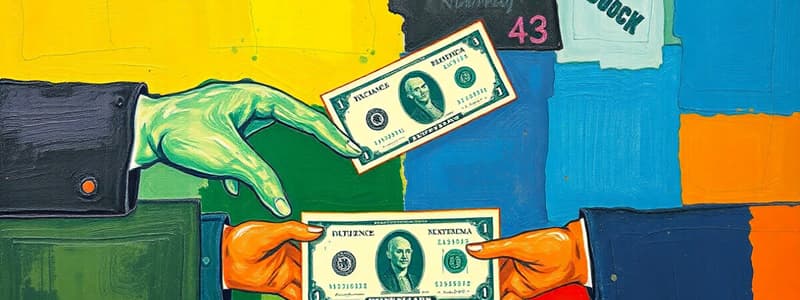Podcast
Questions and Answers
What is the key characteristic that differentiates the "Use of Commodity as Money" stage from the "Barter/Direct Stage"?
What is the key characteristic that differentiates the "Use of Commodity as Money" stage from the "Barter/Direct Stage"?
- The introduction of credit money.
- The use of non-metallic goods as money.
- The establishment of economic interdependence.
- The widespread acceptance of a specific good as a medium of exchange. (correct)
Which of the following difficulties associated with barter is addressed by the use of "Credit Money"?
Which of the following difficulties associated with barter is addressed by the use of "Credit Money"?
- It is cumbersome, inconvenient and indivisible.
- No double coincidence of wants.
- Products do not have the same value.
- Lack of store value. (correct)
Which of the following BEST describes the concept of "Purchasing Power"?
Which of the following BEST describes the concept of "Purchasing Power"?
- The rate at which prices increase or decrease over time.
- The amount of goods and services a person owns.
- The amount of money a person possesses.
- The ability to use money to buy goods or services. (correct)
What distinguishes "Legal Tender Money" from other forms of money?
What distinguishes "Legal Tender Money" from other forms of money?
In the context of money, what is the underlying concept behind the saying "Money talks"?
In the context of money, what is the underlying concept behind the saying "Money talks"?
What is the name of the feature that allows you to see different colors depending on the angle you hold the Philippine banknote?
What is the name of the feature that allows you to see different colors depending on the angle you hold the Philippine banknote?
How do the 'Tactile Dots' feature enhance the security of the Philippine banknote?
How do the 'Tactile Dots' feature enhance the security of the Philippine banknote?
Which of these security features is NOT visible on the surface of the Philippine banknote?
Which of these security features is NOT visible on the surface of the Philippine banknote?
Which of the following is an example of a metallic security feature found on a Philippine banknote?
Which of the following is an example of a metallic security feature found on a Philippine banknote?
What is the primary purpose of the 'Sampaguita Clear Window' on the Philippine banknote?
What is the primary purpose of the 'Sampaguita Clear Window' on the Philippine banknote?
Which of the following is NOT a function of money?
Which of the following is NOT a function of money?
What is the difference between commodity money and currency?
What is the difference between commodity money and currency?
Which of the following describes 'Domestic currency'?
Which of the following describes 'Domestic currency'?
Flashcards
Direct Appropriation Stage
Direct Appropriation Stage
Early man's needs were met by natural resources.
Barter/Direct Stage
Barter/Direct Stage
Goods and services exchanged directly, ending self-sufficiency.
Commodity as Money
Commodity as Money
Goods accepted widely due to usefulness and scarcity.
Legal Tender
Legal Tender
Signup and view all the flashcards
Purchasing Power
Purchasing Power
Signup and view all the flashcards
Sampaguita Clear Window
Sampaguita Clear Window
Signup and view all the flashcards
Polymer Substrate
Polymer Substrate
Signup and view all the flashcards
Enhanced Value Panel
Enhanced Value Panel
Signup and view all the flashcards
Shadow Thread
Shadow Thread
Signup and view all the flashcards
Functions of Money
Functions of Money
Signup and view all the flashcards
Medium of Exchange
Medium of Exchange
Signup and view all the flashcards
Standard Unit of Value
Standard Unit of Value
Signup and view all the flashcards
Commodity Money
Commodity Money
Signup and view all the flashcards
Study Notes
Stages in Exchange Development
- Direct Appropriation Stage: Early humans met needs directly from natural resources.
- Barter/Direct Exchange Stage: Goods and services were exchanged directly for other goods and services. This led to economic interdependence.
- Commodity Money Stage: Certain goods gained wide acceptance as a medium of exchange due to usefulness, beauty, scarcity, and rarity.
- Credit Money: Money with a monetary value greater than its material value.
Money
- Intrinsic value is equal to material, monetary value.
- Derived from the Latin word "Moneta."
- Any item symbolizing perceived value used as a medium of exchange for goods and services; debts and obligations.
- Purchasing power is the amount that can be bought with money, it decreases with rising prices.
Difficulties of Barter
- Products don't always have the same value.
- No guarantee of finding someone who wants what you have to offer.
- Lack of store value and divisibility.
- It is cumbersome, inconvenient, and indivisible.
Types of Money
- Non-metallic: Rice, corn, wheat, salt, tea, cattle.
- Metallic: Gold, silver, copper.
Legal Tender
- Money acceptable by law for all debts.
- Philippine banknotes and coins issued by BSP.
Functions of Money
- Medium of exchange: A common medium for exchanges.
- Unit of value: Measures the value of goods and services.
- Store of value: Can be stored for future use.
- Standard of deferred payment: Used to settle future debts.
Studying That Suits You
Use AI to generate personalized quizzes and flashcards to suit your learning preferences.


